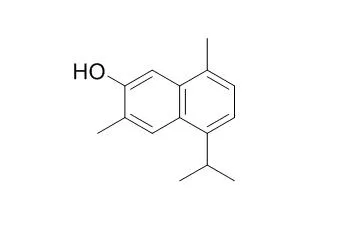Evaluate the potential toxicity of the natural products isolated from H. inuloides and some semisynthetic derivatives.
METHODS AND RESULTS:
The toxic aspects of the following natural products isolated from dried flowers of H. inuloides: 7-hydroxy-3,4-dihydrocadalene (1), 7-Hydroxycadalene (2), 3,7-dihydroxy-3(4H)-isocadalen-4-one (3), (1R,4R)-1-hydroxy-4H-1,2,3,4- tetrahydrocadalen-15-oic acid (4), D-chiro-inositol (5), quercetin (6), quercetin-3,7,3'-trimethyl ether (7), quercetin-3,7,3',4'-tetramethyl ether (8), eriodictyol-7,4'-dimethyl ether (9), α-spinasterol (10), caryolan-1,9β-diol (11) and 7-(3,3-dimethylallyloxy)-coumarin (12) as well as the toxic aspects of the semisynthetic compounds 7-acetoxy-3,4-dihydrocadalene (13), 7-benzoxy-3,4-dihydrocadalene (14), 7-acetoxycadalene (15), 7-benzoxycadalene (16), quercetin pentaacetate (17), 7-hydroxycalamenene (18), 3,8-dimethyl-5-(1-methylethyl)-1,2-naphthoquinone (19), and 4-isopropyl-1,6-dimethylbenzo[c]oxepine-7,9-dione (20). Toxic activities of compounds were determined by sulforhodamine B (SRB) assay, Artemia salina assay, RAW264.7 macrophage cells. Additionally, the acute toxicity in mouse of compound 1, the major natural sesquiterpene isolated from the acetone extract, was evaluated.The best cytotoxicity activity was observed for mansonone C (19) on K562 cell line with IC50 1.45 ± 0.14 μM, for 7-Hydroxycadalene (2) on HCT-15 cell line with IC50 18.89 ± 1.2 μM, and for quercetin pentaacetate (17) on MCF-7 cell line with IC50 22.57 ± 2.4 μM. Sesquiterpenes mansonone C (19) and 7-hydroxy-3,4-dihydrocadalene (1) caused the strongest deleterious effects against A. salina with IC50 39.4 ± 1.07, and 45.47 ± 1.74 μM, respectively. The number of viable RAW 264.7 cells was reduced with sesquiterpenes 1 and 2 by more than 90%. In addition, the acute study of 1 revealed no lethal effects at 300 mg/kg body weight, however, a reduction in the body weight of mice, morphological changes in the tissues of the liver and kidney and toxic signs were observed at very high doses (2000 mg/kg).
CONCLUSIONS:
The results provided evidence for the cytotoxicity of Mexican arnica (H. inuloides) metabolites and may be correlated with one of the popular uses of this plant, in traditional Mexican medicine, as anticancer remedy.
Among the active compounds contained in the acetone extract, the cytotoxic activity is mainly ascribable to cadinene type sesquiterpenes. In addition, evidence of acute toxicity suggests that 7-hydroxy-3,4-dihydrocadalene (1) may lead to toxicity at very high doses. |






 Cell. 2018 Jan 11;172(1-2):249-261.e12. doi: 10.1016/j.cell.2017.12.019.IF=36.216(2019)
Cell. 2018 Jan 11;172(1-2):249-261.e12. doi: 10.1016/j.cell.2017.12.019.IF=36.216(2019) Cell Metab. 2020 Mar 3;31(3):534-548.e5. doi: 10.1016/j.cmet.2020.01.002.IF=22.415(2019)
Cell Metab. 2020 Mar 3;31(3):534-548.e5. doi: 10.1016/j.cmet.2020.01.002.IF=22.415(2019) Mol Cell. 2017 Nov 16;68(4):673-685.e6. doi: 10.1016/j.molcel.2017.10.022.IF=14.548(2019)
Mol Cell. 2017 Nov 16;68(4):673-685.e6. doi: 10.1016/j.molcel.2017.10.022.IF=14.548(2019)